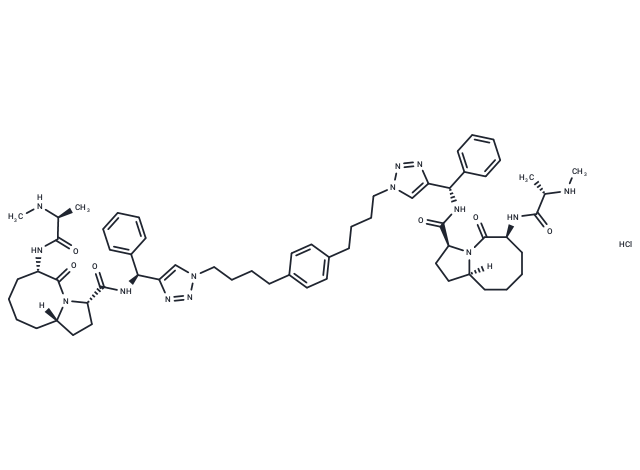Shopping Cart
- Remove All
 Your shopping cart is currently empty
Your shopping cart is currently empty

SM-164 Hydrochloride is a cell-permeable Smac mimetic compound. SM-164 binds to XIAP protein containing both the BIR2 and BIR3 domains(IC50 value of 1.39 nM) and functions as an extremely potent antagonist of XIAP.

| Pack Size | Price | Availability | Quantity |
|---|---|---|---|
| 2 mg | $266 | Backorder | |
| 5 mg | $372 | Backorder | |
| 10 mg | $531 | Backorder | |
| 50 mg | $1,586 | Backorder |
| Description | SM-164 Hydrochloride is a cell-permeable Smac mimetic compound. SM-164 binds to XIAP protein containing both the BIR2 and BIR3 domains(IC50 value of 1.39 nM) and functions as an extremely potent antagonist of XIAP. |
| Targets&IC50 | CIAP:, CIAP1:0.31 nM (ki), CIAP2:1.1 nM (ki), XIAP:0.56 nM (ki), XIAP:1.39 nM |
| In vitro | SM-164 is a non-peptide, bivalent small-molecule, cell-permeable, which mimics Smac protein for targeting XIAP. SM-164 binds to XIAP containing both BIR domains(IC50 of 1.39 nM), being 300 and 7000-times more potent than its monovalent counterparts and the natural Smac AVPI peptide, respectively. SM-164 concurrently interacts with both BIR domains in XIAP and functions as an ultra-potent antagonist of XIAP in both cell-free functional and cell-based assays. SM-164 targets cellular XIAP and effectively induces apoptosis at concentrations as low as 1 nM in leukemia cancer cells, while having a minimal toxicity to normal human primary cells at 10,000 nM[1]. The binding affinities of SM-164 to XIAP, cIAP-1, and cIAP-2 proteins are determined using fluorescence-polarization based assays. SM-164 has a Ki value of 0.31 nM to cIAP-1 protein containing both BIR2 and BIR3 domains.SM-164 has a Ki value of 0.56 nM to XIAP protein containing both BIR2 and BIR3 domains. SM-164 binds to cIAP-2 BIR3 protein with Ki values of 1.1 nM. Addition of exogenous TNFα can significantly enhance the activity of these Smac mimetics, especially for SM-164, in resistant cancer cell lines such as HCT116 and MDA-MB-453[2]. |
| In vivo | In the MDA-MB-231 xenograft model ,SM-164 is highly effective in inhibition of tumor growth and capable of achieving tumor regression . Treatment with SM-164 at 1 mg/kg completely inhibits tumor growth during the treatment. Treatment with SM-164 at 5 mg/kg reduces the tumor volume from 147±54 mm3 at the beginning of the treatment (day 25) to 54±32 mm3 at the end of the treatment (day 36), a reduction of 65%. The strong antitumor activity by SM-164 is long lasting and not transient. SM-164 at 5 mg/kg is statistically more effective than Taxotere at the end of the treatment (P<0.01) or when the tumor size in the control group reaches 750 mm3 (P<0.02)[2]. |
| Alias | SM-164 Hydrochloride |
| Molecular Weight | 1157.88 |
| Formula | C62H85ClN14O6 |
| Relative Density. | 1.31g/cm3 |
| Storage | Powder: -20°C for 3 years | In solvent: -80°C for 1 year | Shipping with blue ice. | ||||||||||||||||||||||||||||||
| Solubility Information | H2O: 106 mg/mL (91.55 mM), Sonication is recommended. | ||||||||||||||||||||||||||||||
Solution Preparation Table | |||||||||||||||||||||||||||||||
H2O
| |||||||||||||||||||||||||||||||

Copyright © 2015-2025 TargetMol Chemicals Inc. All Rights Reserved.